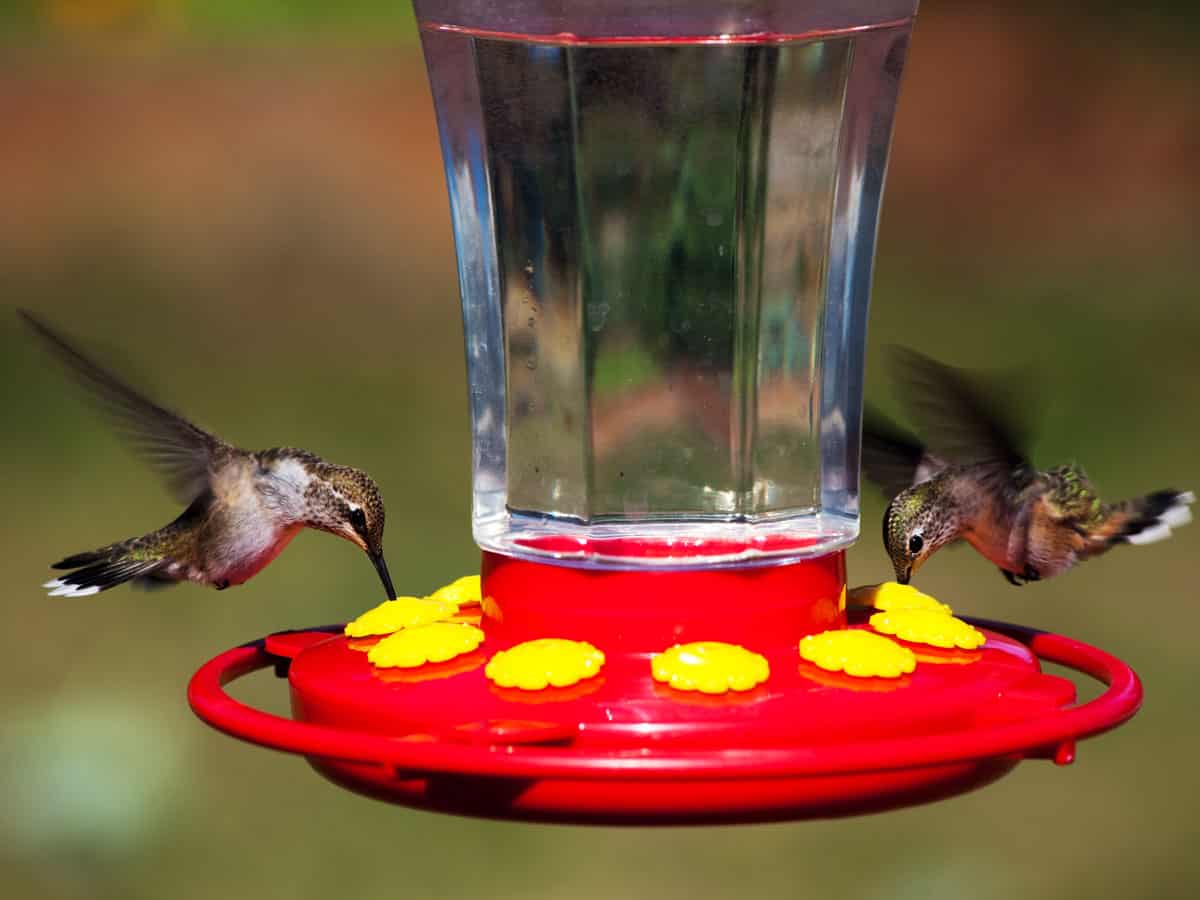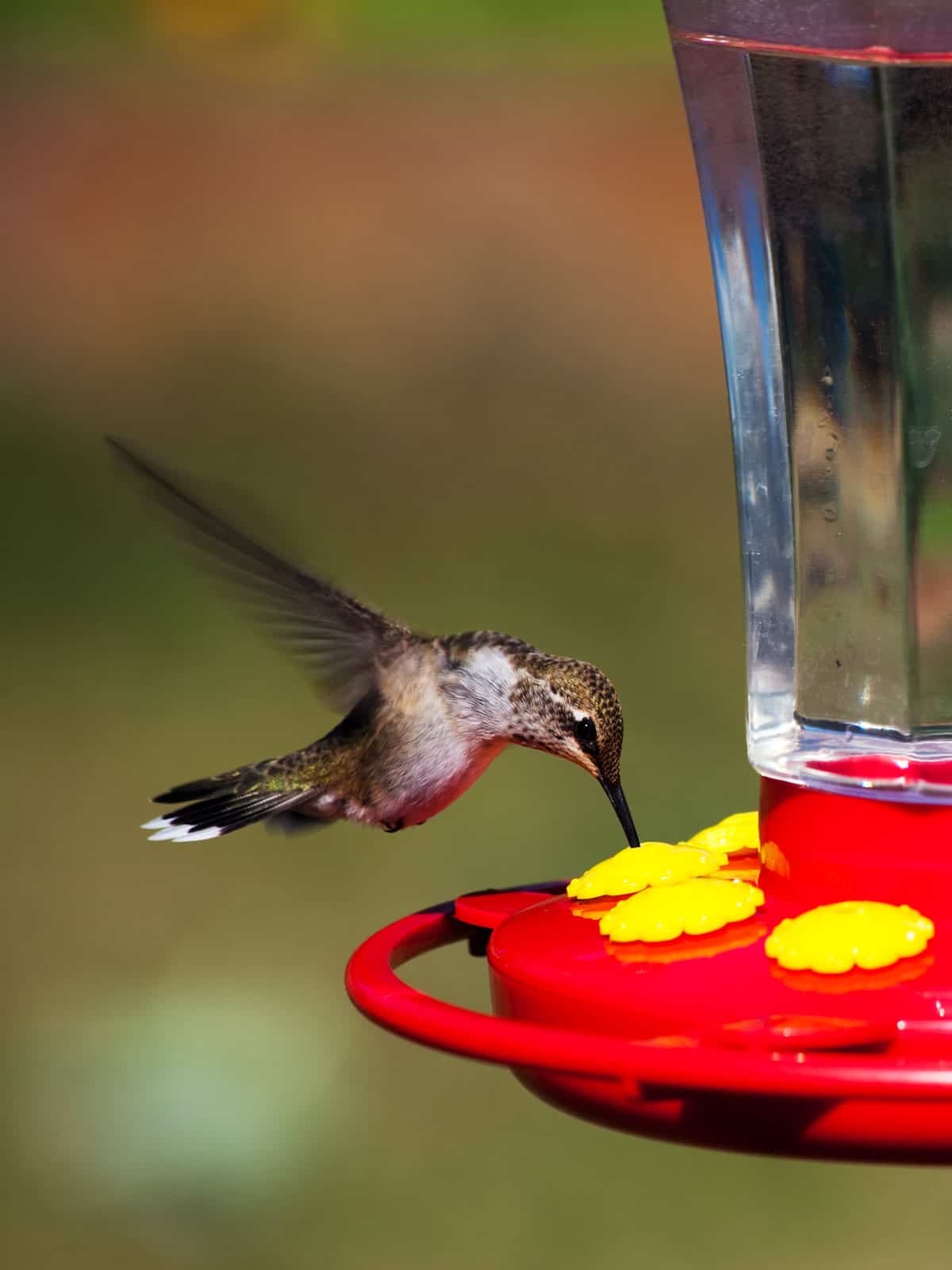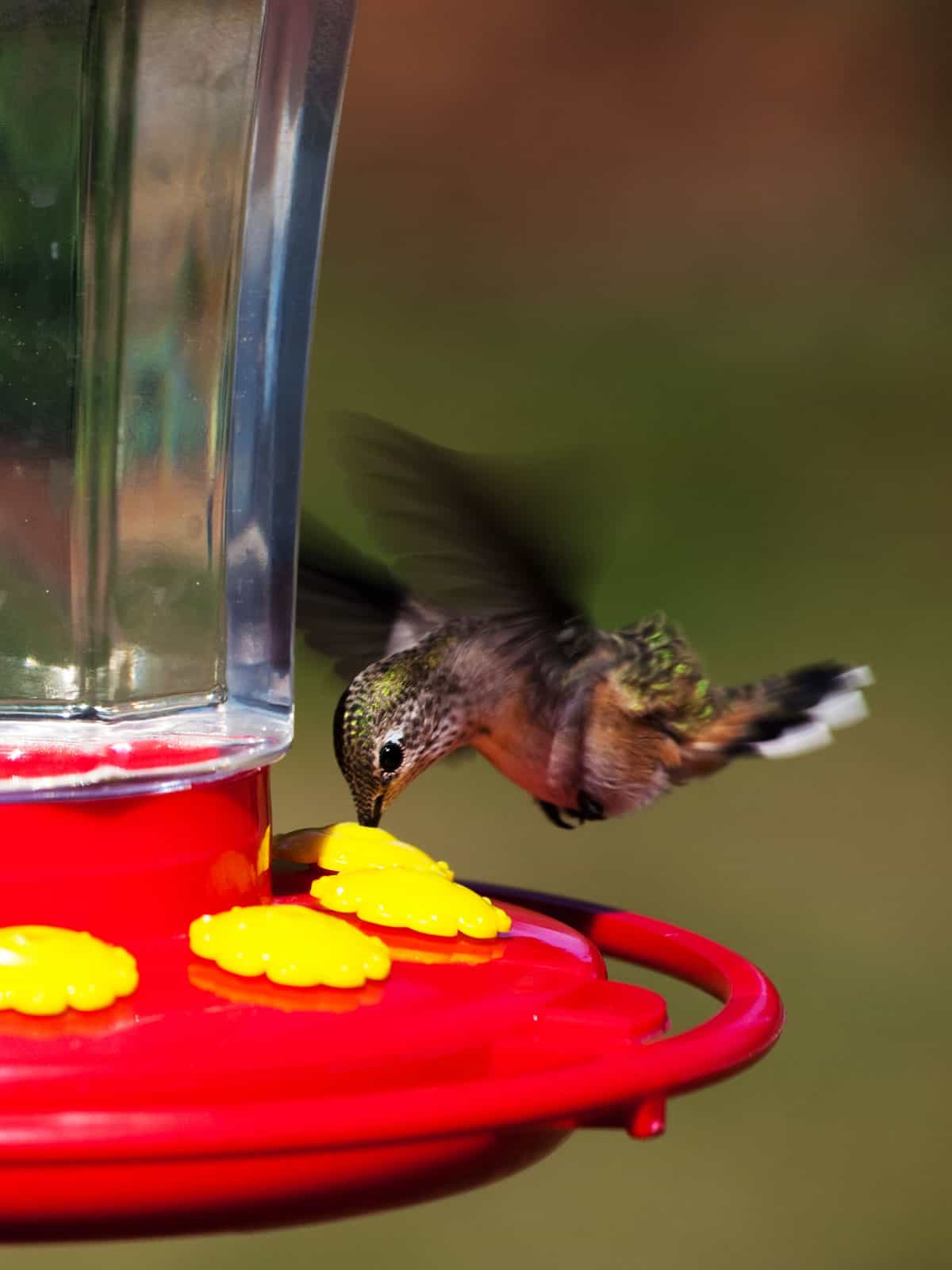Love hummingbirds? Me too! In this post, you’ll learn how to choose the best hummingbird feeder, including 5 specific recommendations for every setting and budget. You’ll also learn how to prepare nectar (with recipes), how to clean your feeder and even where to place it.

Related: How to choose the best cardinal bird feeder
Table of Contents
How to Choose the Best Hummingbird Feeder
That unmistakable flash of intense iridescent green or brilliant blue will have birders running to their window every time. These shy and stunningly bejewelled little birds are prized by birders worldwide and nothing gives greater pleasure than watching them zip around the garden.
A hummingbird feeder is the perfect way to get them to hold still long enough for you to get a good look at that dazzling plumage.
First you will have to discover the delights of hummingbirds – what they like to eat, what they need daily to remain healthy and their personality traits to help coax them into your garden.
Different styles of feeders, where to locate them, nectars and some handy hints on how to keep them healthy alongside the best ways to keep them coming back will all be revealed here.
Do hummingbirds only eat nectar in the wild?
Well the good news is that the nectar from flowers is their favorite thing so once they know your feeder is there supplying them with it, they will keep coming back. But like all birds, a varied diet is what keeps them healthy.
In the wild, hummingbirds eat insects and spiders as well as nectar. They prefer smaller insects like fruit flies, gnats, ants, mites and aphids but also eat spiders and beetles. This gives you the added bonus of organic pest control when they visit your garden.
Handy Hint – It’s a good idea to place some fruit near your feeder so it will attract other insects which in turn provides them with two food sources, doubling your chances that they will become regular visitors.
What is nectar and how do I make it?
Nectar is basically sugar and water so it is very easy to make. This helps fuel those rapidly beating wings with energy, and as one of the smallest and fastest birds, they need all the nectar they can get.
Hummingbirds need to eat half of their body weight daily to keep up with their energy demands.
Nectar is easily made with 1 part sugar to 4 parts water. You can make it yourself or there are many brands of nectar on the market. Just be sure to do your research and make sure isn’t anything harmful in the ingredients list.
What shouldn’t I feed hummingbirds?
Preservatives of any kind, red dyes and electrolytes are regularly included in ingredient lists of bought nectars which wouldn’t be found in the wild so try to get as natural as possible and avoid these ingredients.
Not everything sweet is good for hummingbirds, in fact it can make them sick and be dangerous to their health so avoid incorporating honey, corn syrup, sugar substitutes or artificial sweeteners, molasses and sugary drinks like sodas and fruit juices to your nectar.
Although we consume them, our digestion is very different than that of a small hummingbird, and some of these are not that good for a human body so imagine the effect on a tiny hummingbird.
More reading: How to choose the best premium binoculars (under $500)
Choosing a Hummingbird Feeder
Now that you know what they eat, you can choose a feeder. Chief considerations for choosing a feeder are – color, size, how much it holds, how easy it is to clean and how likely it is to leak.
Bright colors represent flowers and will encourage the hummingbird to come nearer on its quest for food. Red is the most popular color proven to work.
Size does matter when it comes to hummingbird feeders. Remember is full of nectar which does have a life span and the last thing you want is to feed them rotten nectar.
So, like Goldilocks, not too big and not too small, it has to be just right. If you are concerned then start by making smaller batches of nectar until the hummingbirds realize it is there and visit more regularly.
Cleaning a key so you don’t harm our little friends with rotten nectar so choose one that has a wide reservoir and is easy to clean.
Leaking is a concern as most hummingbird feeders are upright so be sure to ask if it is sealed to prevent all of your nectar draining out.
Location: Placing Your Hummingbird Feeder
Choosing a nice shady area of your garden will help entice the hummingbirds. They are wary little birds so offering some protection will make it more inviting.
Hanging from the branch of a tree is ideal. Being out of direct sun and keeping the nectar cooler also helps the nectar from fermenting rapidly.
5 Good Choices for Hummingbird Feeders
There are great feeders available for an affordable price so you may want to buy more than one and increase your chances of a visit. Singular or multiple feeding stations can entice more birds to come and increase your viewing pleasure.
1. More Birds Hummingbird Feeder
This is more than just a feeder. It’s an attraction in itself, well-made and dishwasher safe it is an antique style glass feeder with attractive red flowers on the base to grab a hummingbird’s attention.
A wide reservoir means it is easy to fill and clean while the multiple feeding stations with built in rings to land on attract more birds and increases your chances of them staying there to get a better look at them when they land.
 2. First Nature 3055 32-ounce Feeder
2. First Nature 3055 32-ounce Feeder
This feeder has all the best features. The wide mouth reservoir aids cleaning and filling and the attractive red base incorporates sealing rings to ensure it doesn’t leak.
 3. Birds Choice 32. oz. Hummingbird Feeder
3. Birds Choice 32. oz. Hummingbird Feeder
This is a glass feeder with measurements marked down the side of the reservoir and 8 feeding stations to attract multiple birds at once.
The bright red two-part base comes apart for easy cleaning.
4. More Birds Hummingbird Feeder
This feeder by More Birds is another good choice with 7 flowered feeding stations so they don’t have to go looking and it multiple birds can feed at once.
Glass construction with wide opening means it’s easy to clean and if even has a built-in ant mat.
5. More Birds Brushed Copper Feeder
This More Birds hummingbird feeder is made of brushed copper and glass. This hummingbird tube feeder has a classic look which will add beauty to your garden.
It’s sleek design also makes it easy to clean. It has five feeding stations and holds 14 fluid ounces
What should a good nectar contain?
Healthy with no added preservatives, dyes or sugar substitutes is what you are after on the ingredients list when choosing a good hummingbird nectar to fill your feeder.
A lot of ingredient lists will show – Red Food Dye, Preservatives and Electrolytes. Now, as no research has been done on the impact that they would have on a hummingbird here’s what we do know…these dyes and preservatives are not that good for human consumption so bird lovers definitely wouldn’t want to give their hummingbirds something they themselves wouldn’t eat.
Electrolytes is where most people understandably get a little confused. Firstly, what are electrolytes? An electrolyte is a substance that dissolves uniformly in a solution such as water, becomes ions and acquires the capacity to conduct electricity.
Common electrolytes are sodium, potassium, chloride and bicarbonate. You can read more about electrolytes if you wish here.
All of these electrolytes will be found naturally in other flowers that the hummingbird visits during the day but may be at different levels than those found in nature. This is why staying as natural as possible to their natural diet is the best thing.
They will get everything they need naturally from hundreds of other flowers they will visit. Plus, man made may be in a higher concentration and potentially harm for them.
Natural Nectars Available
EZ Nectar – ticks all the healthy boxes and is proud to say it’s 100% natural. Ready to use, just fill your existing feeder and place the unused portion in the refrigerator or later refills.
They are avid bird lovers as well donating profits to pollinator and bird preservation causes.

It includes a convenient measuring cup to help you mix as much or as little as you need depending on the size of your feeder.

They also include helpful cleaning tips for your feeder, when to change the nectar and warnings not to add any artificial colors and additives.
More reading: Must Have Bird Watching Gear
Nectar Recipes
Making your own nectar is both rewarding and worthwhile. Knowing exactly what goes into the nectar so you are 100% sure there is nothing harmful for one of nature’s greatest delights is gratifying.
Making the nectar is easy enough once you have your ingredients. It only has two ingredients, sugar and water. Sounds simple, right? Well, it is and it isn’t.
- Sugar: Your main two choices for the best natural sugars would be unrefined cane sugar or beet sugar. These most closely resemble those sugars found naturally in hummingbird’s favorite wild flowers so either of those is good.
- Water: This can be tricky. There is actually a bit of a debate among birders about the best water to use – tap, spring, well or distilled. As the water is boiled then any of the first three would suffice to rid it of any nasties that will be floating around in there. As for distilled, it can be so pure as to actually be lacking in some things the birds may need in their diet.
Now you have your ingredients, the formula is easy.
- One part sugar to four parts water = ½ cup sugar, 2 cups water.
Place the water and sugar in a small saucepan and heat on the stove until thoroughly mixed and the sugar is full dissolved.
Extra nectar can be stored in your refrigerator in an airtight container for up to two weeks. If it shows signs of cloudiness or growth then it is no longer any good and should be disposed of.
While this is cooling, it is time to clean your feeder.
Cleaning your feeder
Because feeders are filled with sugar water and this is the perfect medium for bacterial and fungal growth thoroughly cleaning your feeder in-between every fill is vital. This also helps prevent fermentation as it rids any bacteria that may already be there.
The most commonly used agents to clean feeders are the gentler ones like white vinegar or peroxide as they don’t leave a residue behind that may be harmful to the birds. A diluted bleach solution can also be used but you must make sure that it is completely rinsed with no trace left as bleach can harm the birds.
- Glass Feeders: You can place in a large pot of water and gently boil to remove any excess nectar that may be clinging to the nooks and crannies and this will help prevent black mold from forming.
- Plastic feeders: Thoroughly washing with your solution of choice in a bucket is fine. White vinegar solution can be made from one part vinegar to two parts water. Peroxide solution is recommended at about 3% peroxide to 97% water.
If black mold is present when you disassemble your feeder then soaking will be required to ensure no mold spores remain and prevent it from returning.
More reading: How to identify birds by “seeing” their songs
Once your feeder is thoroughly cleaned and dry, you can fill it and hang it in a shady area of your garden then just sit back and relax and enjoy watching those colorful little beauties when they come to visit.
Have a tip to share? Maybe a favorite location or nectar recipe? Join me in the comments!
Drew Haines is an animal enthusiast and travel writer. She loves to share her passion through her writing.
She graduated high school at sixteen and started her own business, Everywhere Wild Media. And she runs Everywhere Wild and JustBirding. She also guest blogs on Storyteller.Travel
She lived in Ecuador for 6 years and explored the Galapagos Islands. Currently based in N.S., Canada.








